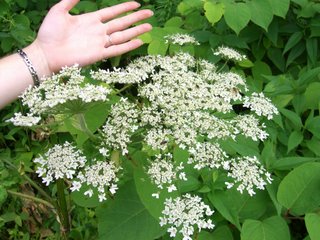Giant Hogweed Sighting

Dear Riverwatch Captains:
I have met many of you at captain trainings and hope to get to know you all better through our new Riverwatch blog. I would like to thank you all for your hard work and dedication to your local streams and rivers.
I'm not a Buffalo native--I grew up in northeastern Pennsylvania (near the great Susquehanna River) and attended Houghton College in Allegheny County, New York. I majored in music, with a concentration in voice, and sociology. I moved to Buffalo last June and joined AmeriCorps in January with a placement at Buffalo Niagara Riverkeeper.
I love my job! I have learned so much about Buffalo-Niagara region's history and the environmental challenges it faces. It's also given me an interesting perspective on other cities' water-related efforts. I recently visted Portland, Oregon and Seattle, Washington while on choir tour. In Portland, I saw a sign along the waterfront detailing the city's struggles with combined sewer overflows on the Willamette River. In Seattle, I saw a billboard questioning the quality of the water supply since the incidence of multiple scleorosis in the Northwest is the highest in the world. Even though these cities are environmentally progressive and popular places to live and visit, they are still dealing with the same issues that we face in our watershed.
The Northwest even has Giant Hogweed, too. Mike Goehle, one of our Riverwatch captains, recently reported a giant hogweed plant along the Buffalo River near the Harlem Rd. fishing access site. Robbyn Drake and I visited the site to get a close-up of this invasive species from Asia. Giant Hogweed is a rather nasty member of the parsley family, which includes Queen Anne's lace and cow parsnip. In appearance, it closely resembles cow parsnip but reaches herculean proportions--hogweed can grow as high as 15-20 feet with leaves 3-5 wide and umbles 2 feet wide. Its sap is most worrisome, however. Hogweed sap causes blistering and sensitizes the skin to ultraviolet radiation. Sun exposure on sap-coated skin can ultimately lead to purplish, blackened scars and outbreaks that can persist for years. Giant Hogweed is classified as a Class A Noxious Weed and a public health hazard. Check out Michigan state's online brochure about hogweed on
http://www.michigan.gov/documents/
MDA_Hogweed_Brochure_2_115074_7.pdf
Please see the picture above.
See you all at the next training and please blog!
0 Comments:
Post a Comment
<< Home